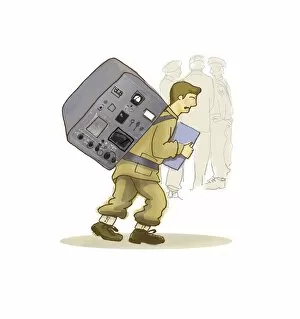Radio Operator Collection
"Remembering the Unsung Heroes: Radio Operators in World War II" In the midst of wireless communication advancements in 1941
All Professionally Made to Order for Quick Shipping
"Remembering the Unsung Heroes: Radio Operators in World War II" In the midst of wireless communication advancements in 1941, artist Cecil Beaton captures the essence of a dedicated RAF bomber radio operator. Their crucial role in ensuring effective communication within the crew cannot be understated. Joining an esteemed RAF bomber crew in 1941, these brave individuals played a vital part in coordinating missions and relaying critical information. Their expertise allowed for seamless teamwork amidst the chaos of war. Gordon Parks' lens transports us to Bethune-Cookman College, Daytona Beach, Florida, in 1943. Here we witness aspiring radio operators honing their skills under expert guidance. These young minds were preparing themselves to serve their country with unwavering dedication. The black and white photograph of a Lancaster Bomber Crew serves as a poignant reminder of those who risked their lives during wartime operations. Among them stands a resolute radio operator, ready to transmit messages that could mean life or death for his comrades. Even King George VI recognized the importance of radio operators during his visit to Southeast England post-attack in 1940. Witnessing firsthand their tireless efforts and commitment further solidified their significance on the front lines. Artwork depicting early portable military radios showcases how technology evolved over time to aid these unsung heroes on dangerous missions. These devices became lifelines connecting crews across vast distances, enabling swift response and coordination. Telecommunications operators from the 1920s exemplify pioneers who paved the way for modern-day radio operators. Their dedication laid strong foundations for future generations to build upon as they navigated uncharted territories within this field. During wartime news transmissions in 1942, radio operators proved indispensable once again by delivering critical updates from far-flung battlefields directly into homes worldwide. They bridged gaps between loved ones separated by war while providing essential information about ongoing conflicts.











